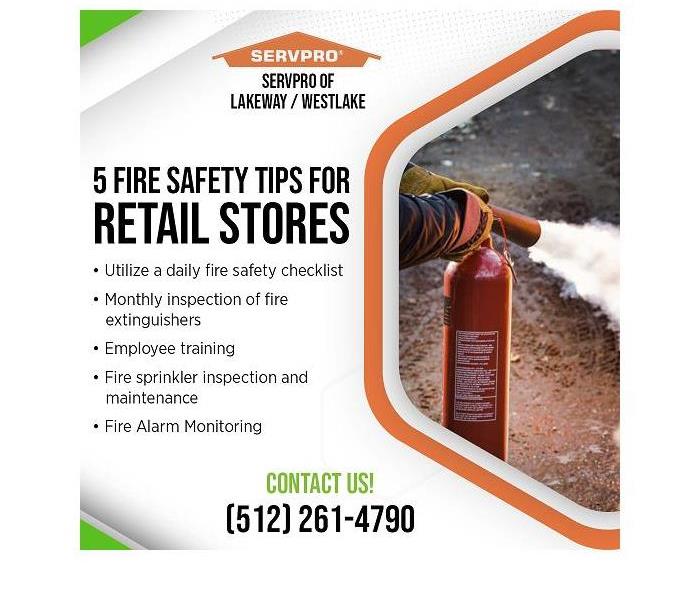SERVPRO: Important fire safety tips for retail stores
8/24/2021 (Permalink)
Blog summary: SERVPRO shares how retail stores can prevent fire damage by following certain precautions.
Fire safety tips for retail stores
Retail stores are usually at high fire risk. By creating a fire protection plan, managers and store owners can minimize fire dangers, protect their clients, and continue running a flourishing business. SERVPRO, a fire damage restoration service, shares some advice.
Identifying the common fire hazards in retail stores:
- Electrical wiring/outlets
- Lighting
- Gas lines
- HVAC/furnace systems and motors
- Kitchen/break room cooking appliances
- Potentially flammable products like chemicals, clothing, paper
- Vandals
- Lightening
5 fire safety tips
- Utilize a daily fire safety checklist
Making fire prevention a part of daily routine is the first step towards fire safety. This safety checklist must be followed by employees daily and every task must be ticked off at the closing time. Here’s what this daily checklist can include:
- The routine must include inspections, repair, and maintenance of electrical wires, gas lines, plumbing, utility connections, and all fire-protection equipment. This ensures that these items don’t pose a fire hazard and function properly when needed.
- Keep flammable items such as paper, clothing, and chemicals away from electrical outlets, flames, and static electricity.
- Keep the kitchen or break room with a hot plate, toaster, or cooking surface, grease-free and clear of clutter. Cooking is one of the biggest causes of commercial fires in the country.
- Dispose of the trash properly - away from electrical and gas appliances that can spark a fire. Trash should not block doorways and evacuation paths during emergencies. An uncluttered space allows for more safety.
- Monthly inspection of fire extinguishers
Fire safety and prevention are incomplete without well-maintained, portable fire extinguishers. It is imperative to ensure they are functional in the event of a fire.
Some basic fire extinguisher rules and recommendations:
- Within 75 feet: The distance to the nearest fire extinguisher in any given direction should not exceed 75 feet.
- The right extinguisher: For every kind of fire, there is a specific fire extinguisher. ABC-class extinguishers put out fires caused by flammable liquids, electronic equipment, and burning paper or plastic. K-class are meant to be used in kitchens and within 30 ft. of cooking equipment.
- The staff must be trained on how and where to use extinguishers
- Monthly inspections as per OSHA (Occupational Safety and Health Administration) and NFPA (The National Fire Protection Association) should be conducted by trained employees to ensure the pressure gauge is on full (needle to green), the hose intact, and the pin securely in place. Annual inspections must be performed by a certified professional and reported to the appropriate organizations.
- Employee training
Proper employee training that is in tandem with NFPA and OSHA standards must be conducted by the business owners. All employees must be trained on fire safety protocol, evacuation procedures, and the use of fire safety equipment. Employees must know the location of all fire extinguishers and fire exits and the procedure to escort customers to safety. A mandatory annual fire safety refresher course is a must for all staff.
Assigning employees specific tasks such as shutting off gas and electrical power and evacuation helps to be more organized during a fire incident.
- Fire sprinkler inspection and maintenance
Regardless of the size of the store and volume of merchandise, fire sprinklers and/or fire suppression systems are the best line of defense against fire damage and loss of life. However, a sprinkler or fire suppression system that has not been maintained and is not code-compliant is useless. Unfortunately, not all retail businesses are required by law to have these systems. Businesses that do install these systems must get their quarterly and annual inspections conducted by a state-licensed technician and as mandated by the NFPA code.
- Fire Alarm Monitoring
No fire safety plan is complete without fire alarm monitoring. This system cuts down on firefighter notification time and speeds up their arrival, saving merchandise, property, and lives. It also ensures that all false alarms are ruled out before alerting for help. This is especially helpful when the store is closed and there is no one to watch the store. Statistically, arsonists were responsible for setting 10,200 non-residential fires in 2018, a 15% increase over ten years. Fire alarm monitoring helps thwart such ill intentions.
Following these tips can really help prevent a fire disaster and the accompanying losses in terms of money and lives. In case of fire damage, retail store owners must reach out to a professional fire damage restoration company such as SERVPRO to restore their property to its original glory.
Why SERVPRO?
- SERVPRO uses state-of-the-art equipment to bring the damaged property back to its original state. SERVPRO of Lakeway / Westlake is always updating its fleet and equipment so clients in Lakeway, Westlake, or anywhere else can quickly access the services.
- With over 1,700 US and Canadian Franchise locations, SERVPRO is strategically positioned to respond faster to an emergency of any magnitude.
- The SERVPRO staff is highly trained in property damage restoration. They receive initial in-house training and constant skill up-gradation at the corporate training facility and also acquire the regular IICRC-industry certification.
For fire damage restoration services, call SERVPRO of Lakeway / Westlake today at (512) 261-4790

 24/7 Emergency Service
24/7 Emergency Service
